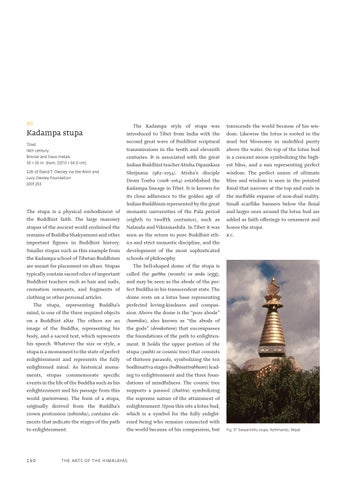90
Kadampa stupa Tibet 14th century Bronze and trace metals 50 × 26 in. diam. ( 127.0 × 66.0 cm) Gift of David T. Owsley via the Alvin and Lucy Owsley Foundation 2001.263
The stupa is a physical embodiment of the Buddhist faith. The large masonry stupas of the ancient world enshrined the remains of Buddha Shakyamuni and other important figures in Buddhist history. Smaller stupas such as this example from the Kadampa school of Tibetan Buddhism are meant for placement on altars. Stupas typically contain sacred relics of important Buddhist teachers such as hair and nails, cremation remnants, and fragments of clothing or other personal articles. The stupa, representing Buddha’s mind, is one of the three required objects on a Buddhist altar. The others are an image of the Buddha, representing his body, and a sacred text, which represents his speech. Whatever the size or style, a stupa is a monument to the state of perfect enlightenment and represents the fully enlightened mind. As historical monuments, stupas commemorate specific events in the life of the Buddha such as his enlightenment and his passage from this world (parinirvana). The form of a stupa, originally derived from the Buddha’s crown protrusion (ushnisha), contains elements that indicate the stages of the path to enlightenment.
160
The Kadampa style of stupa was introduced to Tibet from India with the second great wave of Buddhist scriptural transmissions in the tenth and eleventh centuries. It is associated with the great Indian Buddhist teacher Atisha Dipamkara Shrijnana (982–1054). Atisha’s disciple Drom Tonba (1008–1064) established the Kadampa lineage in Tibet. It is known for its close adherence to the golden age of Indian Buddhism represented by the great monastic universities of the Pala period (eighth to twelfth centuries), such as Nalanda and Vikramashila. In Tibet it was seen as the return to pure Buddhist ethics and strict monastic discipline, and the development of the most sophisticated schools of philosophy. The bell-shaped dome of the stupa is called the garbha (womb) or anda (egg), and may be seen as the abode of the perfect Buddha in his transcendent state. The dome rests on a lotus base representing perfected loving-kindness and compassion. Above the dome is the “pure abode” (harmika), also known as “the abode of the gods” (devakotuva) that encompasses the foundations of the path to enlightenment. It holds the upper portion of the stupa ( yashti or cosmic tree) that consists of thirteen parasols, symbolizing the ten bodhisattva stages (bodhisattvabhumi) leading to enlightenment and the three foundations of mindfulness. The cosmic tree supports a parasol (chattra) symbolizing the supreme nature of the attainment of enlightenment. Upon this sits a lotus bud, which is a symbol for the fully enlightened being who remains connected with the world because of his compassion, but
TH E A RTS O F THE HIMA LAYA S
transcends the world because of his wisdom. Likewise the lotus is rooted in the mud but blossoms in undefiled purity above the water. On top of the lotus bud is a crescent moon symbolizing the highest bliss, and a sun representing perfect wisdom. The perfect union of ultimate bliss and wisdom is seen in the pointed finial that narrows at the top and ends in the ineffable expanse of non-dual reality. Small scarflike banners below the finial and larger ones around the lotus bud are added as faith offerings to ornament and honor the stupa. R.C.
Fig. 37 Swayambhu stupa, Kathmandu, Nepal.
